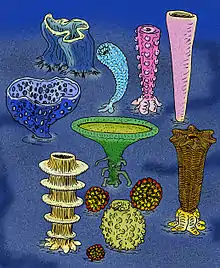Cambrian explosion
English
WOTD – 24 November 2017
Etymology

An artist’s impression of various species of class Archaeocyatha, sponge-like marine animals from the Cambrian period
The word Cambrian was first used in this context by British geologist Adam Sedgwick (1785–1873) who named it after Cambria, the Latinized form of Welsh Cymru (“Wales”), where Britain's Cambrian rocks are best exposed.[1]
Pronunciation
- (Received Pronunciation) IPA(key): /ˈkam.bɹɪ.ən ɪkˈspləʊ.ʒən/
- (General American) IPA(key): /ˈkæm.bɹi.ən ɛkˈsploʊ.ʒən/
Audio (AU) (file) - Hyphenation: Cam‧bri‧an ex‧plo‧sion
Proper noun
Cambrian explosion (plural Cambrian explosions)
- (evolutionary biology) The relatively rapid appearance, during the Cambrian Period around 541 million years ago, of most major animal phyla, as demonstrated in the fossil record.
- 1992, “Evolution of the Earliest Animals”, in J[ames] William Schopf, editor, Major Events in the History of Life [Proceedings from a Symposium Convened by the IGPP Center for the Study of Evolution and the Origin of Life at the University of California, Los Angeles, Held January 11, 1991], Sudbury, Mass.; London: Jones and Bartlett Publishers, →ISBN, page 87:
- Alternatively, if animals had a relatively long Precambrian history, why do so many kinds appear abruptly and more or less synchronously in the fossil record during Early Cambran time? Was there an external environmental factor that either prevented animals from becoming fossilizable (i.e., large muscular, and/or mineralized) prior to the beginning of the Cambrian, or did some biological or environmental event trigger the metazoan radiation? Hypotheses that have been advanced to explain these questions tend to focus on either an external environmental control on, or an internal property of, the organisms that participated in the Cambrian explosion.
- 2008 May, “Affected Environment”, in Draft Programmatic Environmental Impact Statement for Geothermal Leasing in the Western United States (DES 08-22), volume I (Programmatic Analysis), [Washington, D.C.]: US Department of the Interior, Bureau of Land Management; US Department of Agriculture, United States Forest Service, OCLC 232119141, paragraph 3.5.4, pages 3-49–3-50:
- A major adaptive radiation took place during the Cambrian Period that resulted in the evolution of most of the known phyla (broad groupings of organisms) as well as other phyla that have since become extinct. This geologically rapid appearance of diverse multicellular life is referred to as the Cambrian explosion, and is best documented in the fauna of the Burgess Shale (Middle Cambrian-age Stephan Formation) of British Columbia.
- 2011, Michael Ebifegha, “Introduction”, in Creation or Evolution?: Origin of Species in Light of Science’s Limitations and Historical Records, Bloomington, Ind.: iUniverse, →ISBN, page 7:
- Evidence of transitional stages is missing both in the living world and in the "Cambrian explosions" at Burgess Shale in the Canadian Rockies and at the Chengjiang site in China. It is only proper at this point that we demand hard evidence of transitional stages. To wait millions of years for it to appear is simply a scientism of the gaps.
- 2014, Jan Zalasiewicz; Mark R. F. Williams, “Water in the Cosmos”, in Ocean Worlds, Oxford: Oxford University Press, →ISBN:
- A few worlds may have made this giant leap, invented sex (or some equivalent), and produced planets with sponge-like organisms to filter-clean their seas as a precedent to the evolution of more complex life. Here and there, and likely very rarely, a few planets may have undergone their own Cambrian explosions.
- 2015, Andrew H[erbert] Knoll, “In the Beginning?”, in Life on a Young Planet: The First Three Billion Years of Evolution on Earth, new Princeton Science Library paperback edition, Princeton, N.J.; Woodstock, Oxfordshire: Princeton University Press, →ISBN, page 8:
- [T]hese cliffs, cut over the millennia by the Kotuikan as it winds toward the Arctic Ocean, record one of Earth history's great turning points. As well as any rocks known anywhere, they document the remarkable diversification of animal life popularly known as the Cambrian Explosion. In the broadest possible sense, the Kotuikan cliffs record the beginnings of the modern world, a world in which animals swim, crawl, or walk beneath an atmosphere of breathable air. That's really what brought us here.
-
Translations
the rapid appearance, around 541 million years ago, of most major animal phyla
|
|
Noun
Cambrian explosion (plural Cambrian explosions)
- (by extension) The rapid appearance of anything.
- There has been a Cambrian explosion of cryptocurrencies.
- 2009, W[illiam] Brian Arthur, The Nature of Technology: What It Is and How It Evolves, London: Allen Lane, Penguin Group, →ISBN:
- When we examined the detailed history of the evolution, we fond large gaps of time in which little happened at all. Then we saw the sudden appearance of a key circuit (an enabling technology) and quick use of this for further technologies. A full adder circuit might appear after say 32,000 steps; and 2-, 3-, and 4-bit adders fairly quickly after that. In other words, we found periods of quiescence, followed by miniature "Cambrian explosions" of rapid evolution.
- 2011 November 16, Gary Hamel, “Gary Hamel on ‘Hacking Management 2.0’”, in Saba Software; quoted in Marco Minghetti, “Foreword”, in Collaborative Intelligence: Towards the Social Organization, Newcastle upon Tyne: Cambridge Scholars Publishing, 2014, →ISBN, page xxix:
- Before the Web, it was hard to imagine alternatives to management orthodoxy. But the Internet has spawned a Cambrian explosion of new organizational life forms—where coordination occurs without centralization, […]
- 2012, Don Tapscott; Anthony D. Williams, “Five Principles for the Age of Networked Intelligence”, in Macrowikinomics: New Solutions for a Connected Planet, paperback edition, London: Portfolio/Penguin, →ISBN, part I (From Wikinomics to Macrowikinomics):
- The men and women of the Renaissance period likely had little inkling of the truly titanic changes that were unfolding around them, let alone the ability to predict where it would all end up. Nevertheless, many of their legacies remain with us today: the birth of modern nation-states; the expansion of political rights and freedoms; the rise of the university, the media, and the industrial corporation; and a Cambrian explosion of science, medicine, knowledge, and cultural expression.
- 2017, Jan-Benedict Steenkamp, “The Cambrian Explosion of Brands”, in Global Brand Strategy: World-wise Marketing in the Age of Branding, London: Palgrave Macmillan, DOI:, →ISBN, page 2:
- With the advent of mass media in the 1960s, immortalized in the TV series Mad Men, the pace of brand introduction, sophistication, and importance accelerated dramatically. The world has witnessed a "Cambrian explosion" of brands.
References

- [Adam] Sedgwick; R[oderick] I[mpey] Murchison (1835), “On the Silurian and Cambrian Systems, Exhibiting the Order in which the Older Sedimentary Strata Succeed each other in England and Wales”, in Notices of Communications to the British Association for the Advancement of Science; at Dublin in August 1835, London: John Murray, Albemarle Street, published 1836, OCLC 31097972, pages 59–61.
This article is issued from Wiktionary. The text is licensed under Creative Commons - Attribution - Sharealike. Additional terms may apply for the media files.